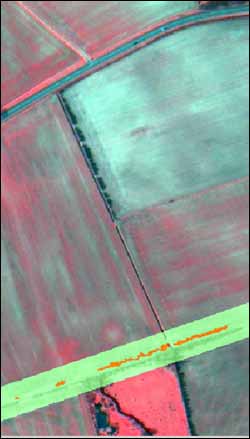Plants used to detect gas leaks, from outer space!

Satellite image of gas leaks from a pipe supplied by Prof. Mike Stevens
Gas leaks can be potentially life threatening in the home, but the presence of gas stresses out plants too. Professor Mike Steven and colleagues from the University of Nottingham have found that changes in the physical properties of plants can act as an early warning of leaks in natural gas pipelines. “Our study was about testing the ability of satellite remote systems to monitor gas leaks via the spectrum of reflected light from plants, which changes when the plants are stressed”, says Steven. “A satellite image of the stress responses in vegetation should identify gas leaks at least as well as a visual report from a helicopter, which is the current method, and would be safer and possibly cheaper.” Steven will present his research on Thursday 6th April at the Society for Experimental Biology’s Annual Main Meeting in Canterbury [session P3]
In the UK in 2001, emission of methane from the gas distribution system was 16% of the total UK methane emissions; such losses are not only costly to the gas distributors, but can contribute to global warming since methane has a global warming potential about 8 times that of CO2. When plant roots are starved of oxygen the stress caused to the plant can be quantified from the spectral quality of light reflected from the leaves, even before the plant looks to be stressed. In the area surrounding a gas leak the escaping methane means the plant roots cannot get enough oxygen and so aerial parts of the plant appear stressed in satellite images detecting reflected light.
This remote-sensing technology can be used to detect any type of stress that causes asphyxiation of the plant roots. Steven and his colleagues are already considering other uses for the detection system. One such application may be to detect carbon dioxide leaking from underground stores used in proposed carbon capture and storage schemes. These stores are intended to help to prevent global warming: the argument is that if CO2 is sequestered indefinitely in underground reservoirs then it can’t be acting to absorb heat in the earth’s atmosphere. “Our own research attempts to address some of the issues related to public acceptability and safety: Will there be leaks? What environmental effects will any leaks have? Can we detect leaks?” says Steven.
Media Contact
All latest news from the category: Ecology, The Environment and Conservation
This complex theme deals primarily with interactions between organisms and the environmental factors that impact them, but to a greater extent between individual inanimate environmental factors.
innovations-report offers informative reports and articles on topics such as climate protection, landscape conservation, ecological systems, wildlife and nature parks and ecosystem efficiency and balance.
Newest articles

Combatting disruptive ‘noise’ in quantum communication
In a significant milestone for quantum communication technology, an experiment has demonstrated how networks can be leveraged to combat disruptive ‘noise’ in quantum communications. The international effort led by researchers…

Stretchable quantum dot display
Intrinsically stretchable quantum dot-based light-emitting diodes achieved record-breaking performance. A team of South Korean scientists led by Professor KIM Dae-Hyeong of the Center for Nanoparticle Research within the Institute for…

Internet can achieve quantum speed with light saved as sound
Researchers at the University of Copenhagen’s Niels Bohr Institute have developed a new way to create quantum memory: A small drum can store data sent with light in its sonic…





















